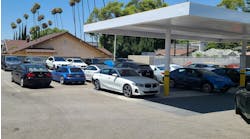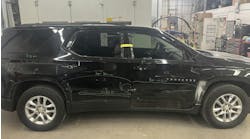Customer expectations are one of the most important issues faced by collision repair facilities. Color match and overall appearance are still where customers seem to focus.
When customers come to pick up their vehicles, they may have a number of questions about the repair, and you can almost guarantee they will have an opinion about the look and color match.
Should the color match be perfect right out of the can? With state-of-the-art finishing at the factory, OEMs struggle to match components finished in different parts of the plant and even in separate plants. In some industries, coils of steel and aluminum arrive for forming already color-coated, eliminating the need to paint the product after it is made. All components for a product are produced from the same color stock, so they match perfectly. The automotive industry is not yet there, so modules painted in different places must match when brought together for final assembly.
The control of color matching in the factory involves very sophisticated color measurement and constant testing to compare colors, but even with this level of sophistication, variations will exist in the actual color. In collision repair, the resources are not yet in place to achieve this level of control. Vehicles coming in for repairs also have degraded color and shine caused by sun and environmental fallout.
Color technicians at the paint companies create formulas for each color as new models are introduced, unless they happen to be the OEM supplier for a given vehicle. Teams of experts develop the color formulas and variants within production runs for refinishers. Even with this effort to achieve color matches, a blendable match is the collision repair industry standard for matching color. All paint manufacturers recommend this approach. In this process, the damaged or replaced panels of the vehicle are painted with a color that is a very close match. That color is then is faded to the edges of repaired panels or onto adjacent panels. Slight variations between the vehicle color and the refinish color are usually not noticeable because the two colors are not adjacent to one another.
A Blendable Match
Is it impossible to match colors perfectly? No, but it is very difficult and can be extremely time consuming. However, it's much less difficult and less time consuming than an angry customer with a comeback.
A few generations of paint products ago, all paints were reversible-the finish can be softened or liquified with a solvent. Lacquer paint, for example, could be wiped off with the same lacquer thinner it was reduced with. With these products, a technique known as "spot painting" was possible. A repaired area was primed and prepped for painting only in the area immediately around the damage. The top coat was sprayed over the "spot" to achieve full hiding, and color was blended out a few inches.
A Little History
Then, a blending solvent was sprayed over the edges, "melting" the color into the existing finish. The blending solvent softened the original paint, and the old and new became one continuous finish. Light sanding and polishing completed the repair. Blending the color out resulted in a visibly acceptable color match, and because the new paint melted into the old, the durability of the finish was maintained.
The sail pane was frequently blended in this manner, avoiding the need to paint the roof. With reversible finishes, this was a state-of-the-art repair. But as paint chemistry progressed, repair techniques had to evolve. Today's OEM and refinish materials are non-reversible finishes, which dictate a different approach to blending.
Today, blending is a different process. The chemistry used in top coat materials today is non-reversible. Many base coats are still not catalyzed, but they are covered with a clear coat, which is a catalyzed product. Top coats are not simply dried but are cured by a chemical reaction. When the paint is cured, it forms a durable plastic that is not affected by the solvents used to thin it during the painting process. Therefore, melting a color or clear into the existing finish is not possible. The bond between an existing finish and the refinish material is mechanical. This means there are fewer options available to the painter.
State-of-the-Art Blending
The process of blending differs in that the clear coat, or color coat in the occasional single stage finish, is not designed to be faded out within a panel. A thickness of 1.3 mil. minimum must be maintained for a clear coat to perform as intended. If a blend or spot repair is performed in the traditional way, the clear will be faded or tapered to a very thin layer. This layer of clear may not hold up to UV and other environmental hazards. This is a common problem when repairing a quarter panel, where no bodyline exists to end the clear coat. (Note: Currently, none of the major paint manufacturers will extend warranties to such repairs. For the full warranty to apply, the clear must extend to all edges of the panel.)
Additionally, trim must be removed to ensure the clear does not bridge onto any trim pieces, creating a failure point where the clear could lift. "Again, paint system manufacturers typically require molding and trim removal to satisfy their warranty requirements."
There have been recent styling and design improvements made to automobiles that improve aerodynamics, reduce noise and keep out inclement weather (rain and cold). They have employed polymeric trim pieces that seal tightly to the body panel. Because of their close contact, they are simply impossible to paint around.Automakers have been equally clear about the proper procedures for some years. Randy Profeta, senior technical training administrator for Toyota Motor Sales USA, states in a letter from 1996: "Since Lexus and Toyota vehicles utilize cross-linked clear coats containing thermosetting resins, it is not possible to 'blend into' the clear coat. While many painters employ a procedure that melts the clear coat overspray, this procedure simply 'blends onto' but not into the factory finish. Our research has shown that this tapered edge will eventually break down. We, therefore, recommend-as do several paint companies who are offering extended or lifetime paint warranties-that clear coat not be tapered or blended in this fashion."
Toyota repair manuals show a repaired right quarter panel that requires color coat on that quarter panel and clear on that panel, the roof and the left quarter because there is not a place to tape off to stop the clear.
Paint manufacturers are still selling blending solvents to melt the overspray before it has cured and to soften the edge of a spot refinish. The message seems to be, "We know you are going to do spot repairs and blends within a panel, so here are the tools but we will not guarantee such repairs."
Finding the balance between properly repairing vehicles and keeping the costs low is always difficult. In this case, neither collision shops nor insurance companies have a choice. If proper warrantees are to be in force, the clear coat must continue to all edges.
The goal of blending is to achieve a color match between the repaired section of the vehicle and the original paint job, so the process naturally starts with looking at the color match. First, make a sprayout card. Blank cards are available from all paint venders and several aftermarket sources. Most have a black and white contrasting pattern, such as a checkerboard, and many have a hole in the center to facilitate comparison with the vehicle. Comparing the sprayout card with the vehicle will either verify that the formula chosen is blendable or demonstrate the need to try a different variant or possibly even tint the color. The variant formulas are necessary to match all the slight variations of the color caused by differences in application within the manufacturing process.
The Basic Process
A sprayout card should be sprayed under exactly the same conditions the vehicle will be sprayed, using the same gun, air pressure and so on. Sprayout cards painted out on the shop floor will most likely not produce the same color as that applied in the booth. A clear coat needs to be applied because this will have an effect on the look of the color. Discovering that a color is not blendable only after color has been applied to the vehicle will result in needless delays.
Prepping the panels should be done following the specific manufacturer's guidelines for the brand of paint the shop uses, but here is a generic version:
- After priming any repaired areas, sand with P400-P600 in the area to be fully color coated.
- In the area to be blended with color, sand with P600-P800.
- The area to be cleared only should be prepped with P1000 or a blend prepping cleanser and a gray scuff pad. Many paint manufacturers prefer the P1000 over a scuff pad. Especially important when sanding with finer grits is to thoroughly sand all edges.
- With the proper color and prepping, finish coating may begin. Color is applied to any new panels and any repaired areas to achieve full hiding. The number of coats will vary with the paint system and color.
- The last coats of color should be sprayed onto the original finish of a repaired panel and onto any adjacent panels. These coats should be faded out with each coat extending farther out from the repair than the last. Clear coat should then be applied to the entire panel or panels as necessary.
There are repair situations when you'll make the decision to blend the clear within a panel. For instance, a customer paying out of pocket for a quarter panel repair may request cost-cutting options. Full disclosure of all consequences is essential to avoid dissatisfied customers and undue liability exposure. The area where the clear will be faded out should be prepared past where the clear will stop and then polished after the clear has cured. This will produce the most long-lasting and least visible repair.
Special Cases
Three-stage paints present a slightly more complicated repair: The base color must be blended first, then the mid-coat is blended past that, and finally, the clear coat is applied. Three-stage blends are essentially two blends within the same area-which may extend past one panel. With the consistent quality of current pearls, this type of blend is not terribly difficult but does require considerably more area to achieve an acceptable finish.
Occasionally, custom paintwork must be repaired in the collision shop. Custom vans with dozens of stripes, or hand-painted wood grain, are an example of widespread non-OEM paint. Another widespread example is the second color fade from top to bottom that has become popular on pickup trucks in the South west. These are frequently done on new vehicles before or immediately after delivery to the customer.
To restore such vehicles to pre-accident condition, the fade must be restored from top to bottom, while a blend is achieved from side to side. There are two ways to do the fade and, when refinishing, the same technique should be used to achieve the same effect. In one, the color being faded is diluted with clear and sprayed in successive layers with more clear added each time. This was a technique used with lacquer and results in rather thick paint. The current preferred technique intermixes the original color with the second color in a shifting mix (100 percent, 30/70, 50/50, 70/30, etc.) and sprayed in layers until the original color is blended into the new. This procedure avoids building up a color coat that is too thick.
The condition of adjacent panels may influence the blend decision. For example, a new fender bolted onto a vehicle with rusted-out doors will not be blended. The customer should be made aware of the cosmetic issues at the beginning of the repair process. Slight damage on an adjacent panel will become much more noticeable if cleared over. Customers should be made aware of such damage and should be presented with options: Repair the damage, blend over, paint only the damaged or replaced panels, or accept a small color mismatch.
A point disputed occasionally between shops and insurance companies is how much to pay for painting and blending various panels. All insurance companies and collision repair facilities write estimates using crash guides that list vehicles with parts and labor times for the most common collision repairs. Paint times are listed for refinishing new, undamaged panels. If two or more adjacent panels are painted, certain portions of the setup work are done only once. Small deductions are made to allow for this. Blend time is calculated at 50 percent of the full panel paint time.
Compensation
Mitchell International Information Systems, Motor/CCC and ADP each publish a guide to the estimating sections, or P-pages. These pages are constantly revised as repair procedures evolve. In recent years, revisions have helped clarify some of the common refinish concerns, including differences between spot painting and blending, distinctions between a new panel and a repaired panel, and requirements from major paint manufacturers regarding clear coat.
Spot painting was once a very small repair, and consequently, the time allowed was reduced from full panel time. Today, that process is not possible with non-reversible finishes. The evolved process may still be called spot painting or blending color within the panel. It involves painting the repaired portion of the panel, blending the color on part of the panel and clearing the full panel. All estimating guides state that this process is different from blending, which is done for the purpose of color match only.
In a letter to John Loftus, former executive director of the Society of Collision Repair Specialists (SCRS) from May 11, 2000, Philip Cunningham, director, database development estimating guide products at MOTOR Information Systems points that out: "It is important to emphasize this 50 percent formula is intended for use in only those instances when attempting to blend newly applied color of the initial panel onto an undamaged adjacent panel in order to achieve proper color transition or match between the new paint and the existing paint. The 50 percent formula is not intended for estimating time that may be required to refinish any panel with damage."
Tom Fleming, vice president of database development and communication at Mitchell International, points out that paint times are based on time studies done in production shops on new panels. The blend times are also based on observations. He explained that there are several steps in painting a panel that are not done when blending onto an undamaged panel. Only one sanding step is involved, and no priming is needed on a blended panel.
Rick Tuuri, senior director of industry relations for ADP Claims Solutions Group and immediate past chairman of the I-CAR Board of Directors, also says the 50 percent calculation is based on observations in production paint departments. The three largest time savings were found in machine sanding, 10 percent; hand sanding, 11 percent; and spraying the color, 10 percent. Not spraying primer on the blended panel saved additional time.
Regarding paint times for repaired panels, Tuuri explains that ADP had included refinishing repaired panels in the most recent time studies and had observed refinish times which varied from 25 percent to 267 percent when compared to full panel time. Such wide variations, attributable to the amount of damage, cannot be accommodated in an automated formula in an estimating system. The time to refinish repaired panels will remain a judgment call to be made by the parties involved in the repair process. All times listed in ADP are for undamaged panels. As listed in the ADP Reference Manual, "Operations that might be considered in the repair time include any steps required to bring the panel to the condition of a new undamaged panel."
Blending the refinish color onto the original color, whether within the damaged panel or onto adjacent panels, is the industry accepted, state-of-the-art method. The context of an individual repair will often determine exactly how this process is implemented. Along with a complete understanding of the blending process, a thorough reading and understanding of the procedures in the estimating guides will help facilitate those discussions about exactly what should be done. m


